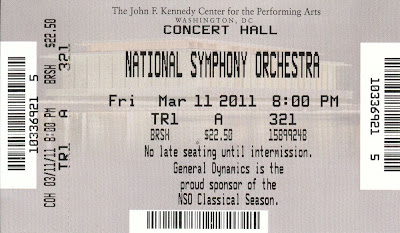D. C. public is so funny: the Kennedy Center Concert Hall was half-empty when the NSO performed Olivier Messiaen's Turangalîla-Symphonie on Friday evening, and there was quite a few walk-outs. I can't believe that music written in 1948 still seems “avante-garde” to some. Turangalîla-Symphonie is stylistically eclectic: it somehow combines Wagnerian exaltation of mysterious love and Brucknerian seriousness of naive religiosity with the Bernsteinian energy and openness of emotion, plus an almost literal descriptiveness redolent of film music. And yet, all this, quite mysteriously, jells together and works, perhaps due to the Messian's sincere Catholic faith.
It was a joy to see two soloists working together so well: Cédric Tiberghien (piano) and Tristan Murail, who studied with Messiaen (ondes Martenot). Christoph Eschenbach definitely deserves credit for programming this piece.
The Turangalîla Symphony may not be everyone's cup of musical tea. It's long, boisterous, sometimes ravishingly beautiful, sometimes intensely and horrendously ugly. Some impatient audience members have been known to discretely head for the exits during its performance.
That attitude, however, is unfair. The 20th century abounds with examples of music that abandons its audience while favoring a kind of inbred academic experimentation that ignores the audience's need for meaning and human emotion in its music. Messiaen doesn't ignore this at all. But he also refuses to limit his musical palette. His symphony is ultimately an extraordinarily visceral journey through heaven and hell, and the composer seems to be saying, “if the horrors of hell sound like they do in my symphony, so be it.”
Yet on the other hand, after a long, 80-minute journey, the symphony erupts into a celebratory dance of pure joy, love on a human, divine, and epic scale. It's a 20th century masterpiece that’s sometimes a difficult listen, but a challenge that's also worth embracing.
It's also an early and intriguing intersection of ancient, traditional, and modern musical ideas, blending acoustical instruments with one of the electronic instruments that arguably led to the Moog synthesizer and today's ubiquitous electronic effects. It’s the novel experience of listening to a genuinely classical composer who's not afraid to insert modern inventions into his own musical experience.
Such a symphony does need an introduction. Wisely, during this weekend’s concert programs, Maestro Christoph Eschenbach and his soloists will be joined onstage by musicologist Joseph Horowitz at the beginning of the evening. They’ll host a lecture/discussion on various aspects of the symphony before breaking for intermission. The audience will then return to listen to the symphony in its entirety, fully able to discern the twists, surprises, and intellectual challenge that this most cerebral of works has always posed. It should be an interesting weekend.
Ponick, T. (2011), 

No comments:
Post a Comment